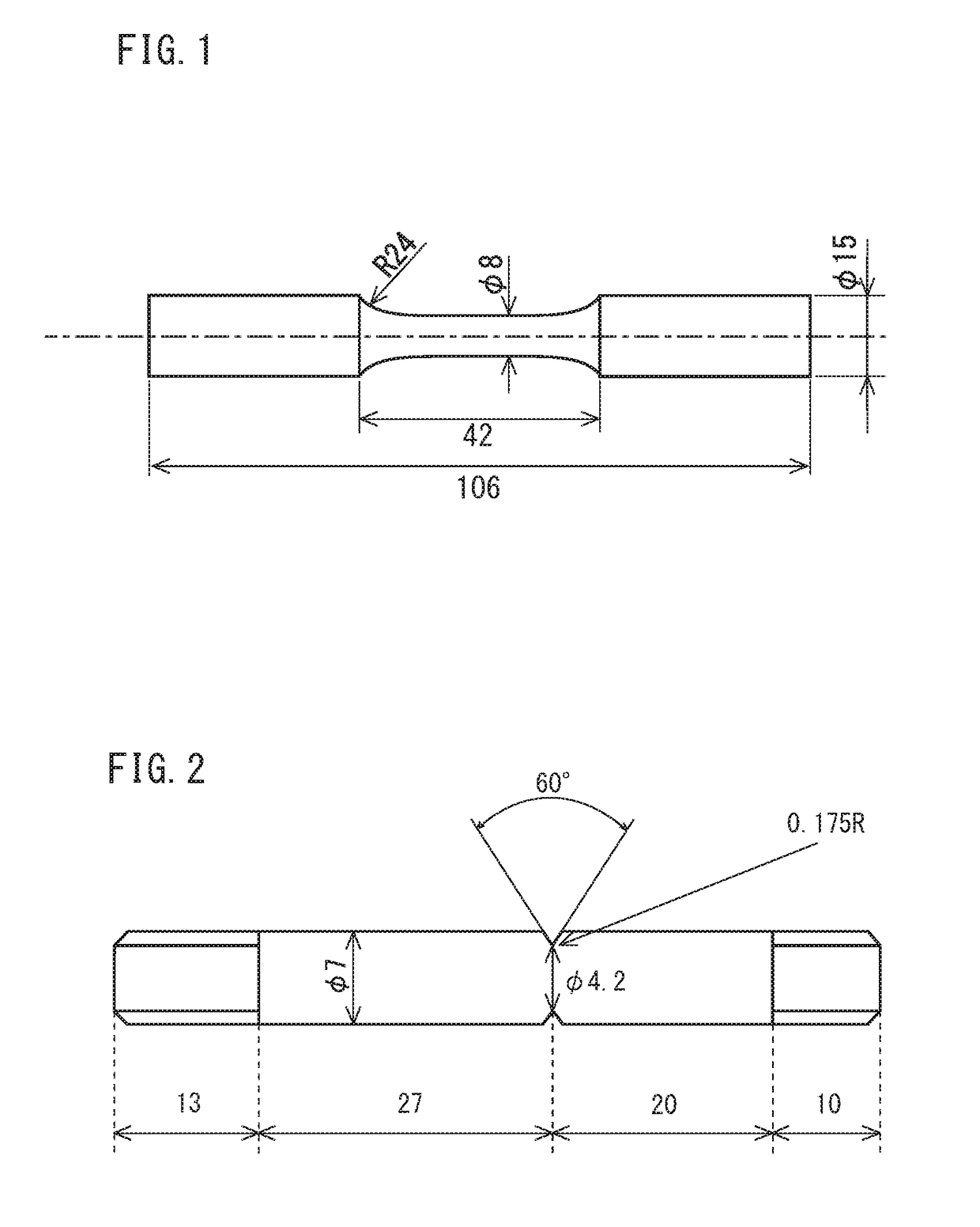Rolled Rod for Cold-Forged Thermally Refined Article
a technology of cold-forged and thermally refined articles, which is applied in the field of rolling rods, can solve the problems of low hydrogen embrittlement resistance, and achieve the effects of excellent cold workability, excellent hydrogen embrittlement resistance, and high strength
- Summary
- Abstract
- Description
- Claims
- Application Information
AI Technical Summary
Benefits of technology
Problems solved by technology
Method used
Image
Examples
example 1
[0132]Molten steels having chemical compositions shown in Table 1 were produced.
TABLE 1Chemical Composition (unit is mass percent; balance is Fe and impurities)SteelCSiMnPSCrAlTiBNOCuNiMoVNbfn1fn2a0.310.420.330.0090.0101.060.0360.0210.00250.00440.0013—————0.661.27b0.370.410.390.0080.0111.160.0380.0190.00190.00320.0012—————0.751.05c0.260.650.250.0060.0091.050.0400.0240.00300.00390.0014—————0.612.60d0.350.800.340.0120.0101.210.0390.0220.00270.00410.00130.020.040.04——0.772.35e0.310.650.240.0110.0051.210.0310.0200.00240.00410.00160.020.060.050.03—0.702.71f0.290.410.310.0100.0091.420.0320.0200.00240.00400.00150.020.030.020.010.030.721.32g0.330.650.550.0110.0090.920.0280.0260.00310.00400.0018—————0.711.18h0.230.410.260.0100.0140.720.0310.0240.00230.00380.0014—————0.491.58i0.391.250.390.0100.0051.260.0320.0210.00150.00400.0013—————0.883.21j0.340.360.380.0110.0090.740.0280.0180.00220.00610.0015—————0.620.95k0.290.350.400.0100.0030.750.0320.0220.00190.00400.0014——0.02——0.580.88l0.360.240.660...
example 2
[Test Method]
[0156]A plurality of blooms of a steel a and a steel grade d were produced. The blooms were heated to at heating temperatures T1(° C.) shown in Table 3 and thereafter subjected to the billeting to produce billets each having a cross section of 162 mm×162 mm. The billets were produced into round bars each having a diameter of 20 mm under producing conditions (heating temperature T2, finishing temperature T3, working rate Z, and cooling rate) shown in Table 3.
TABLE 3F + P Pro-Cooling TotalEutectoidHeatingHeatingFinishingWorkingRateArea ferrite AreaTestTemperatureTemperature TemperatureRate Z(° C. / FractionFractionTSColdNumberSteelT1 (° C.)T2 (° C.)T3 (° C.)( / sec)min)Structure(%)(%)(MPa)WorkabilityRemarks13a125010207956.80.5F + P10038650∘InventiveExample14a105010207926.80.5F + P10038645xComparativeExample15a125011007906.80.5F + P10036705xComparativeExample16a125010207893.40.5F + P10025705xComparativeExample17a125010209006.80.5F + P10024715xComparativeExample18a125010207966....
PUM
| Property | Measurement | Unit |
|---|---|---|
| tensile strength | aaaaa | aaaaa |
| temperature | aaaaa | aaaaa |
| temperature | aaaaa | aaaaa |
Abstract
Description
Claims
Application Information
 Login to View More
Login to View More - R&D
- Intellectual Property
- Life Sciences
- Materials
- Tech Scout
- Unparalleled Data Quality
- Higher Quality Content
- 60% Fewer Hallucinations
Browse by: Latest US Patents, China's latest patents, Technical Efficacy Thesaurus, Application Domain, Technology Topic, Popular Technical Reports.
© 2025 PatSnap. All rights reserved.Legal|Privacy policy|Modern Slavery Act Transparency Statement|Sitemap|About US| Contact US: help@patsnap.com

